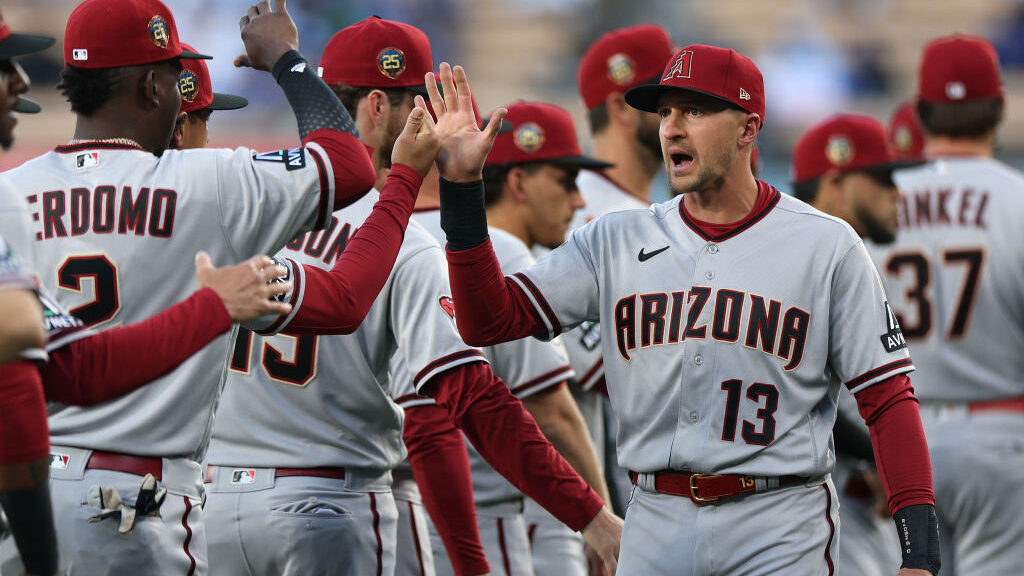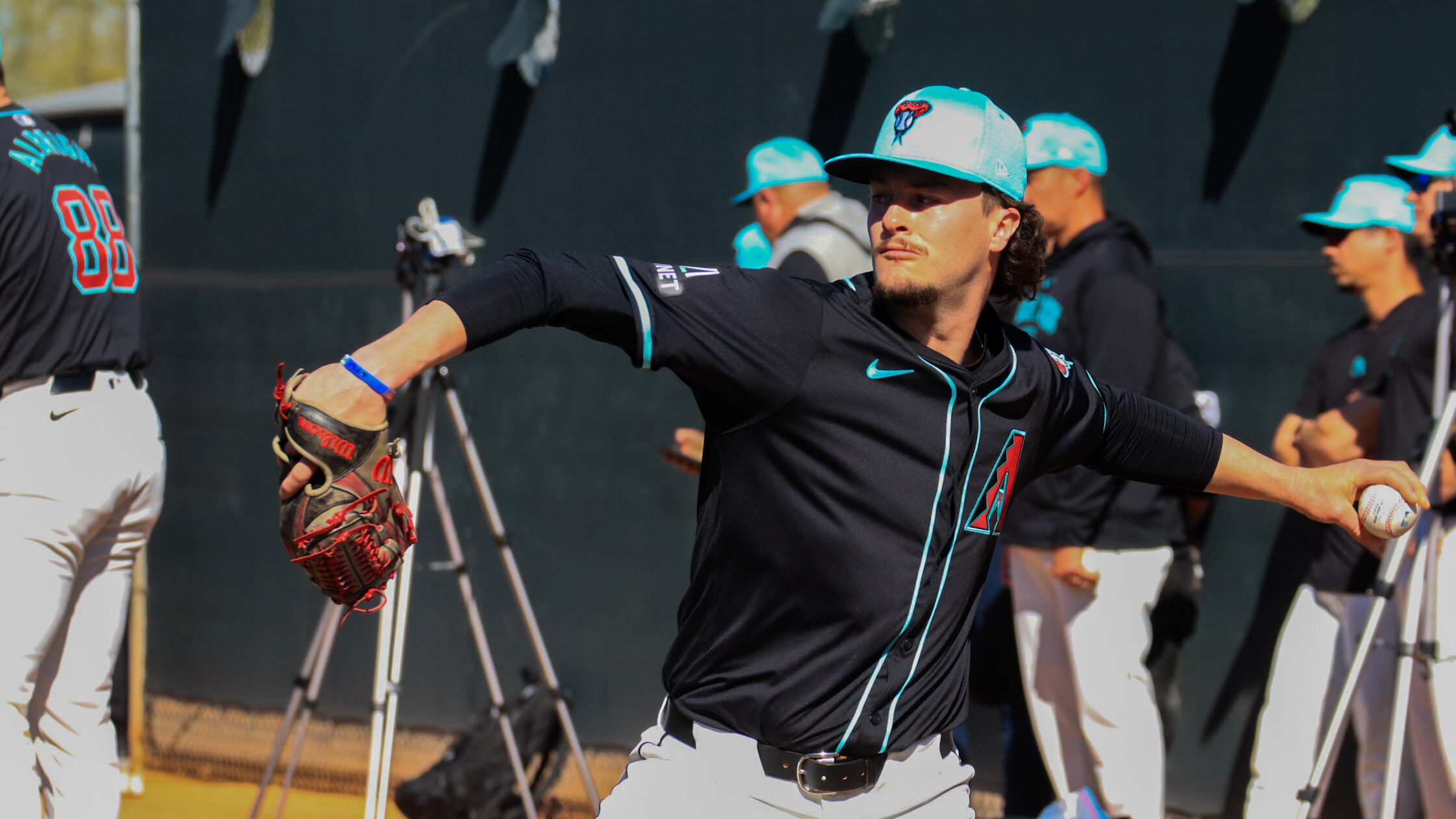Fixing Merrill Kelly’s cramps not as easy as D-backs cranking Chase Field AC
Sep 7, 2023, 9:10 AM | Updated: 3:14 pm

Merrill Kelly (L) #29 of the Arizona Diamondbacks shows his glove to third base umpire Manny Gonzalez #79 prior to the start of the eighth inning against the Colorado Rockies at Chase Field on September 04, 2023 in Phoenix, Arizona. Diamondbacks won 4-2. (Photo by Norm Hall/Getty Images)
(Photo by Norm Hall/Getty Images)
PHOENIX — Arizona Diamondbacks starter Merrill Kelly had to leave a third straight home game with right hamstring cramping on Monday, something that has not popped up in another ballpark this season.
Kelly called the environment in Chase Field “still super hot,” even with air conditioning keeping the announced game temperatures in the mid-to-upper-70s
“I changed my jersey after the fourth inning. I don’t know if it’s just the stadium being old,” Kelly said. “The temperature definitely dropped in the last couple of weeks, not as hot as it was, it’s still hot out there. I know it’s still a big metal box that we’re in. But I’m definitely sweating more here than I am other places.”
The announced temperature for game time on Tuesday was 78 degrees compared to 99 degrees outside. This has been a record-breaking summer for heat in the Valley, so has that made pitching at Chase Field this year feel different?
“You definitely feel kind of muggy out there,” starter Zach Davies said. “I mean, it’s turf so it’s a little bit different than grass and dirt. I guess I can’t really tell the difference between last year and this year. You definitely feel warm out there.”
“It’s always an adjustment going somewhere else, because we play inside all the time,” reliever Joe Mantiply added. “I’ve come to feel really comfortable in this ballpark. I wouldn’t say (there’s a difference). I mean, they keep it pretty cool. Luckily, being inside we get to play in the same temperature pretty much every day. I don’t think it’s been a factor.”
Why not just turn up the Chase Field air conditioning?
Diamondbacks CEO and president Derrick Hall told Arizona Sports’ Bickley & Marotta on Thursday that he appreciates Kelly had reached out directly about whether the organization could cool down Chase Field after his cramping issues first cropped up.
At that point, it was more “inquisitive,” according to Hall.
“When one of your two top players is coming out of games because he’s dehydrated and cramping, you have to correlate it to the conditions, right, to the heat, to what’s happening in the building,” Hall said. “We’re trying to do everything we can for him, with him.
“I don’t think it’s any warmer than it has been in the past, say, five years, because we’ve noticed it (change) over time.”
Logistically it’s not so easy because Chase Field is cooled by a dated chilling system that is attached to many downtown buildings, Hall said.
In other words, according to Hall, there’s not a Chase Field HVAC system or a set of thermostats that allow for the D-backs to further cool just their building.
The team is working with the owners of the chilling plant and consultants to find answers. The D-backs are also trying to determine if they can add an HVAC system to Chase Field in the short- and long-term, according to Hall.
It’s also a matter of outside conditions. This weekend, Phoenix is expected to break its previous record of 53 days of 110-degree Fahrenheit weather in a single year, set in 2020.
The Diamondbacks’ competitiveness this year has also drawn more fans, which means more doors opened to the stadium letting that record heat in.
How pitchers manage the different Chase Field heat
Reliever Kyle Nelson didn’t notice much of a temperature difference from 2022, either, only noting it may be more humid at times. The humidity is something manager Torey Lovullo brought up postgame on Monday.
Each park brings its own set of conditions, as Nelson said his feel for the ball in “artificial air” is different versus outdoor parks.
Closer Paul Sewald is getting used to his new home park after joining the team at the trade deadline.
Sewald said his wife told him it looks like he’s been sweating more on the mound recently. It’s quite an environmental change from pitching in Seattle, but he said he likes feeling warm out there.
Granted, he doesn’t have to do so for 85-100 pitches.
“I need it warm, it makes my body feel better, makes my arm feel better, so I appreciate it,” Sewald said. “Maybe there’s something to it when it’s 115. It’s hard to pump enough AC in here. … I just came from Seattle, where, for the first three and a half months, it’s freezing cold. So it’s a little bit different.
“It’s just one of those things that, I would say that I really like it warm and hot and humid and that sort of thing.”
Lovullo felt Kelly’s frustration on Monday but said his concern level going forward was at a two out of 10. He said there is a lot of sweat involved with a Kelly outing, and these cramps didn’t prevent him from giving Arizona quality starts.
Kelly has had cramping issues during his career pitching in South Korea, but he said they haven’t flared since 2019.
Assistant general manager Amiel Sawdaye told Arizona Sports’ Wolf & Luke on Wednesday that the cramps are minor and go away, noting other pitchers have not had the same issues on this level.
Third baseman Jace Peterson told Burns & Gambo he sees Kelly “crushing” water and eating bananas to be in the best spot, as Kelly attempts hydration strategies with the nutrition staff.
Kelly and Lovullo have said the cramping is not related to the pitcher’s blood clot in his right calf this year, but there is still a level of unknown as to what is happening.
Kelly has asked about that, but a team spokesperson said the air conditioning is as low as it can be on game days. The same system that cools most buildings in downtown, including Chase Field, is over 25 years old.
Hall said addressing the AC situation is among the considerations regarding the future of the ballpark and its infrastructure, with the D-backs’ lease up in 2027.












